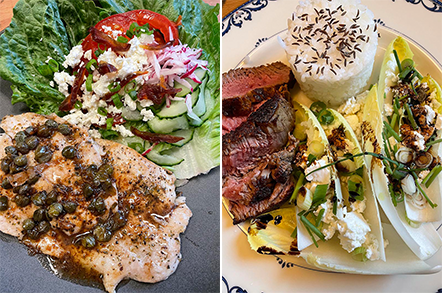
There are few dishes more pleasing to me than a plate of pasta with a delectable sauce. As a child, I remember wanting to eat pasta almost every single day, and now that I am grown up, I admit that I sometimes prepare pasta for breakfast (Indian Seviyan with curry leaves, turmeric, and grilled cashew nuts), lunch, and dinner. Definitely an item that I would crave on a deserted island!
As Marcella Hazan once wrote, setting pasta and sauce correctly together “cannot be ignored by anyone who wants to achieve the full and harmonious expression of flavor of which Italian cooking is capable.” There is another school of thought where one does whatever one wants with pasta and sauce. This seems in the eyes of a pasta aficionado easily dismissible although it is a way of cooking that extends to Italian chain restaurants. I will admit that having tried many of Hazan’s recipes, I have always found them a little bland, even when cooking them when I lived in Venice where I could shop for identical ingredients at her favorite Rialto market.
Pasta dishes are complex. In addition to the chosen sauce, you must pay close attention to the shape (believe it or not but there are over 600 forms ranging from long to short, ruffled, ridged, tubes, and tiny enough to use in a soup), each one ‘ideal’ to complement the sauce and achieve a balance between texture and flavor. Finally, there is a third essential component: the ubiquitous Parmegiano-Reggiano. Well, not to be used in pasta dishes that include fish and shellfish; but that might be explored in a future blog.
Parmegiano-Reggiano should be lightly sprinkled over the pasta after being shaved or grated, and please avoid dumping heaps of cheese onto the dish, that will result in binding the pasta together ad infinitum. This hard and granular Italian cheese is characterized by its balanced saltiness which adds flavor to any dish. When done correctly, it is a feast worth of all Italian kingdoms set together.
Feta cheese

Image 1: Tart with feta cheese and chives (author’s collection)
Being Swiss, there are many other wonderful favorite cheeses that I favor. From the staple Gruyères named for the region (I spent six years at boarding school near the cheese factory), to Emmental, also named for its region, to the Fribourgeois Vacherin; each lend a particular flavor that can be devoured with crackers or melted as with the traditional Swiss fondue. Of course, there are the British, French, Italian, and Spanish staple cheeses that bring so much depth and terroir to any meal.
Recently, I rediscovered feta cheese and have integrated it into many dishes. This distinctive cheese is a staple of many Eastern Mediterranean cuisines. The cheese is typically made of sheep’s milk or a combination of sheep and goat milk. Contrary to decades ago, when it was considered more of a luxury item, you can now find it readily available in grocery stores, or even better, at your local farmer’s market. However, there are various qualities and the generic versions—i.e., found in the processed dairy aisles—are far from the quality that deserves your attention.
Feta cheese is brined, which means that the product is pickled in a high-concentration of salt, thus giving it the nice tangy flavor that the cheese acquires after the brining process. It is said, but not verified, that feta was brined so that it could be shipped by sea around the Mediterranean as long ago as the Bronze Age.
Precedence
I fell in love with feta, especially after reading the book Salt, Fat, Acid, Heat; Mastering the Elements of Good Cooking by Samin Nosrat, after viewing the Netflix series by the same name. In the salt chapter of her book, I learned about other ways of giving flavor to each dish; for example, adding saltiness through either typical or exotic salts, but more importantly, through items such as Kalamata olives, sardines, capers, anchovies, pickled vegetables (including ketchup to my surprise), soy and fish sauces, miso paste, prosciutto, pancetta, and bacon, nori and other seaweeds, and, finally, Worcestershire sauce. Through tinkering, adjusting and perfecting various salts, the cooking and seasoning of foods becomes, in its own right, a cultural art form.
In the process of researching and cooking, I learned how feta could become in my cooking repertoire, a powerful enhancer to my favorite dishes. Instead of salting, I would add feta cheese to my staple dishes outside of the regular Greek salad, feta dip, watermelon with feta, spanakopita, and tiropita to name a few.
Perhaps equally important to finding multiple ways to use feta, was that during the self-imposed Covid-19 period, I was trying even harder to never waste food, thus the challenge to be innovative in creating new ways to use any ‘left-over’ feta. The following photographs are dishes that include feta cheese that I came to rely on during this time.




Conclusion
To end with Marcela Hazan, it is said that she “could tell when a dish needed more salt by simply smelling it.” Feta not only delivers the necessary saltiness to your palate, but adds a beautiful deep white color, a smooth texture, and above all, an entire Mediterranean culinary culture at your fingertips.
Bon Appetit!
Additional blogs of interest
Lasagna with radicchio, pancetta and taleggio sauce